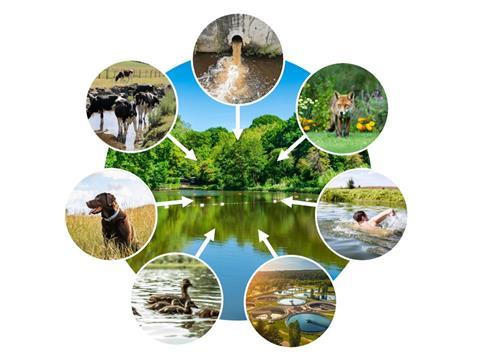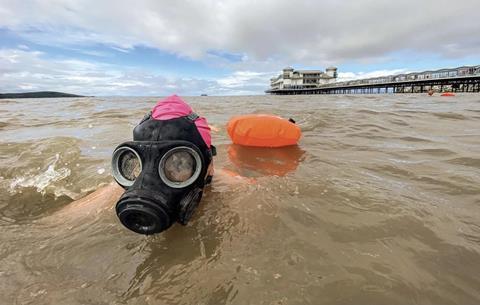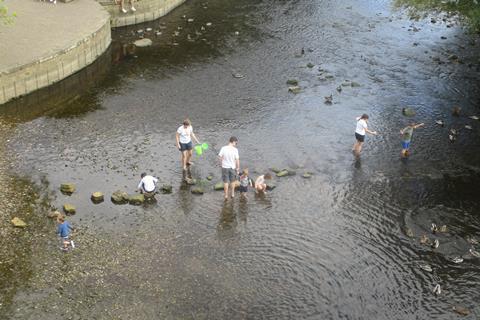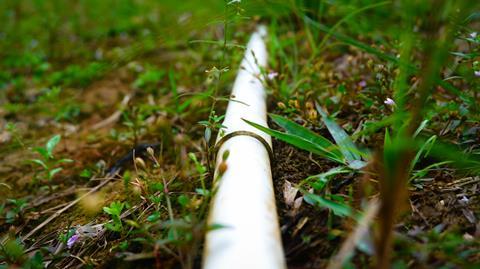The pandemic changed the way many of us connect with the outdoors. Wild swimming and other aquatic pursuits have seen an increase in public interest since 2020, and with that, a heightened awareness of water quality.
Microbial water quality has long been judged based on the presence of certain faecal indicator bacteria such as Escherichia coli (E. coli) and enterococci. These bacteria are abundant in the faeces of warm-blooded animals. They are easy to detect, and, historically, their presence has correlated with health risks. However, these indicators can only tell you that faecal contamination is present – not where it came from. A high E. coli reading could originate from a sewer overflow after heavy rain, run-off from a dairy farm upstream, or droppings from a flock of gulls nearby. Each source demands a different response, and without knowing the source, interventions may be ineffective or misdirected.

Faecal pollution of water bodies is a growing concern globally. In Europe, annual bathing water reports show that whilst most monitored sites achieve the highest quality classifications, many still experience short-term or seasonal contamination linked to factors such as heavy rainfall and infrastructure failures (EEA, 2025). In England, of the 450 designated bathing sites assessed in 2024, 91.8% met legal standards, but only 62.4% were classified as Excellent, and 8.2% did not meet the minimum bacteriological standards (DEFRA, 2025). In the United States, 61% of 3,187 beach sites tested in 2024 reported at least one day of unsafe faecal contamination, with 453 beaches experiencing unsafe levels of faecal bacteria for at least a quarter of days tested (Environment America, 2025). What unites these diverse contexts is that faecal contamination often stems from multiple, overlapping sources, such as wastewater, agriculture, and wildlife. Understanding which sources dominate is key to solving this challenge.

A method of targeted source attribution
Microbial source tracking (MST) offers a way to identify the host animal or group of species responsible for faecal contamination. The concept emerged in the late 1970s, when researchers began profiling gut bacteria by their biochemical and phenotypic traits, such as the ability to metabolise specific carbon sources or patterns of antibiotic resistance. Whilst these methods hinted at source-specific differences, they were slow, labour-intensive, and often lacked precision. The early 2000s introduced a new era of source-specific faecal tracking with the advent of molecular biology techniques such as polymerase chain reaction (PCR), followed by inventions in sequencing and metagenomics. These DNA-based approaches can detect sequences unique to the gut microorganisms of specific hosts, enabling much greater sensitivity and specificity. Today, MST methods fall broadly into two categories:
Library-independent methods
Library-independent approaches mostly use quantitative PCR (qPCR) to detect and quantify host-specific genetic markers directly in environmental samples. PCR-based approaches amplify nucleic acid sequences (DNA or RNA) to levels that can be detected, and in qPCR, this amplification is tracked in real time, allowing the concentration of the target sequence to be quantified. Host-specific faecal genetic markers have been developed based on gene sequences of various microorganisms, including bacteria and viruses. For example, the HF183 marker is associated with a strain of the Bacteroides bacterium found almost exclusively in human faeces. Similarly, adenoviruses can be detected and quantified using qPCR, with different strains of the virus showing high specificity to certain species or groups of species (e.g. humans, sheep, or birds) (Farkas et al., 2024). These assays are rapid, cost-effective, and can be multiplexed, allowing multiple markers for different host groups to be monitored simultaneously. However, qPCR can only detect markers that have been developed and validated in advance, necessitating a good understanding of the different faecal sources potentially impacting a water body.
Library-dependent methods
Library-dependent approaches are based on sequencing of the entire microbial community in a sample and comparing it to reference libraries built from known faecal sources. These methods are designed to handle complex genomics data, where thousands of microbial sequences are processed and analysed simultaneously to resolve source contributions. Tools such as SourceTracker (Knights et al., 2011) use statistical models to estimate the proportion of the community originating from each source. These approaches can handle complex pollution scenarios. However, they are non-quantitative and depend heavily on the quality and representativeness of the reference data. They are also more expensive, labour-intensive and time-consuming than qPCR, often requiring weeks to months for analyses. Further, an initial enrichment via culturing is often needed for species/sub-species-level identification, which may exclude the isolation of any viable but not culturable bacteria and viruses.
In practice, the choice between these approaches depends on the investigation. If a rapid turnaround and cost control are priorities, qPCR-based methods may be preferable. Where multiple overlapping sources or unusual contributions are suspected, sequencing-based approaches can provide a fuller picture.

MST in action
Whilst many MST studies remain rooted in academic research, there is increasing interest from water utilities, environmental regulators, and public health agencies worldwide in applying these tools to operational bathing water management. MST can add value at several stages of a water quality investigation:
- Identifying priority sampling locations
- Refining risk assessments
- Guiding interventions and long-term mitigation strategies
In practical terms, an end-to-end, MST-informed bathing water investigation would typically:
- Define likely pollution sources in the study area, such as sewage discharges, agricultural runoff, or wildlife hotspots
- Design a sampling plan that captures both temporal and spatial variability. This may involve collecting samples during different weather conditions, at multiple points across a watercourse and its tributaries, and from relevant environmental matrices such as slurry and raw sewage.
- Combine MST outputs with faecal indicator bacteria counts, hydrological data, and land use mapping to reveal patterns that would not be visible using bacterial counts alone
MST approaches have been successfully applied to water quality investigations globally and have in some cases proven key to changing the course of these investigations and subsequent management decisions. In Florida, a watershed experiencing repeated failures to meet faecal indicator bacteria standards was found to be primarily impacted by bird faeces, as opposed to sewage. This finding followed two years of MST testing across water, sediment, and vegetation using human and avian markers. The outcomes of the study allowed the site to be reclassified under ‘natural source exclusion’ provisions, avoiding costly remediation measures (Nguyen et al. 2018).
Beyond individual site management, large-scale MST studies have been used to map faecal source patterns across entire river catchments. A study of the River Wharf in the UK, conducted with the support of the local water utility, combined MST with microbial community profiling. This revealed key pollution sources, including sewage treatment works, septic tanks, and agricultural runoff, with heavy rainfall amplifying the load from both human and livestock origins (Karunakaran et al., 2024).

The application of MST is not limited to recreational waters. In drinking water systems, MST has been used to trace contamination following water mains breaks or to investigate persistent low-level failures in vulnerable supplies. In stormwater and wastewater management, it has helped identify illicit cross-connections and pinpoint failing infrastructure. MST has also been employed following waterborne disease outbreaks to investigate potential contamination sources, guiding targeted remediation.
What’s the catch?
MST is a powerful tool, but it is not a silver bullet. The data it generates requires expert and context-specific interpretation.
One of the challenges is marker variability. Library-independent approaches rely heavily on the specificity and sensitivity of markers, namely the exclusivity of the marker to its target host, and its ability to detect host faecal contamination even at low concentrations. Some markers, particularly those designed to target animal groups, experience cross-reactivity issues, reducing their ability to reliably indicate faecal contamination from their target animal. Furthermore, a marker that performs well in one region might not perform as reliably in another, due to differences in diet, gut microbiota, and animal management practices. This is why local validation is critical before results are used to inform decision-making.
The lack of standardisation is another barrier. Different laboratories may use different DNA extraction methods, qPCR protocols, and data interpretation thresholds. These variations can affect sensitivity and specificity, making cross-study comparisons difficult. Environmental conditions can also influence marker persistence, with sunlight, temperature, pH, and salinity all influencing how long genetic markers are detectable after being shed. A human marker detected in a sample might represent a pollution event from that morning, or one that occurred several days earlier.
Due to these uncertainties, a ‘toolbox’ approach is increasingly encouraged in MST investigations. This means integrating it with additional contextual information such as faecal indicator bacteria data, sanitary surveys, hydrological assessments, and land mapping. In combination, these datasets allow for a more confident interpretation of MST results. In this way, MST can be seen as one piece of a larger investigative puzzle.
Looking ahead
Technological advances are making MST faster, more sensitive, and more portable. Portable qPCR devices are already bringing lab-grade testing capabilities into the field, allowing same-day source tracking at a riverbank or beach. Rapid turnaround of results can be important for time-sensitive decisions, such as issuing health advisories or tracing pollution pathways during short-term pollution events. At the same time, digital PCR techniques – particularly droplet digital PCR (ddPCR) – offer improved sensitivity and greater resilience against environmental inhibitors. Unlike qPCR, which estimates DNA concentration based on fluorescence during amplification, ddPCR partitions a sample into thousands of droplets and counts positive reactions directly, providing absolute quantification without the need for standard curves. This makes it easier to detect low-concentration markers in complex water matrices. Beyond PCR, prototype biosensor platforms are emerging that could, in the future, enable continuous in-situ monitoring of host-specific faecal markers, providing near-real-time data to inform management actions during the bathing season.
As methods become more refined and accessible, the potential applications of MST could extend further into related areas, including drinking water, agricultural irrigation water safety and aquaculture biosecurity. MST shows particular promise in drinking water applications and could be a valuable tool to support water utilities in microbiological contamination investigations within the drinking water network. Routine implementation of MST in treated waters is currently limited, however, by the sensitivity of qPCR assays to the characteristically minimal microbial contamination and low concentrations of MST markers in treated drinking water. At present, the most effective role for MST in this area lies in source water assessments, where identifying and mitigating faecal pollution in raw waters can reduce the burden on downstream treatment processes. MST also offers value in assessing the microbial safety of irrigation water, which in many water-scarce regions is increasingly drawn from recycled or untreated wastewater, representing a potential pathway for faecal pathogens into food production.

The climate crisis adds a sense of urgency to these developments. More intense rainfall events are expected to increase surface runoff from agricultural land, wash greater volumes of faecal material into rivers and coastal waters, and place additional pressure on already strained sewer systems. In many regions, this is expected to lead to more frequent, severe, and unpredictable pollution spikes. As pollution events increase in frequency, pollution source tracking will take on greater urgency to protect public health and prioritise investment.
For regulators tasked with protecting water users, MST offers a promising way to identify and source faecal contamination. A comprehensive understanding of faecal source attribution is crucial for ensuring the safety of recreational waters.








No comments yet